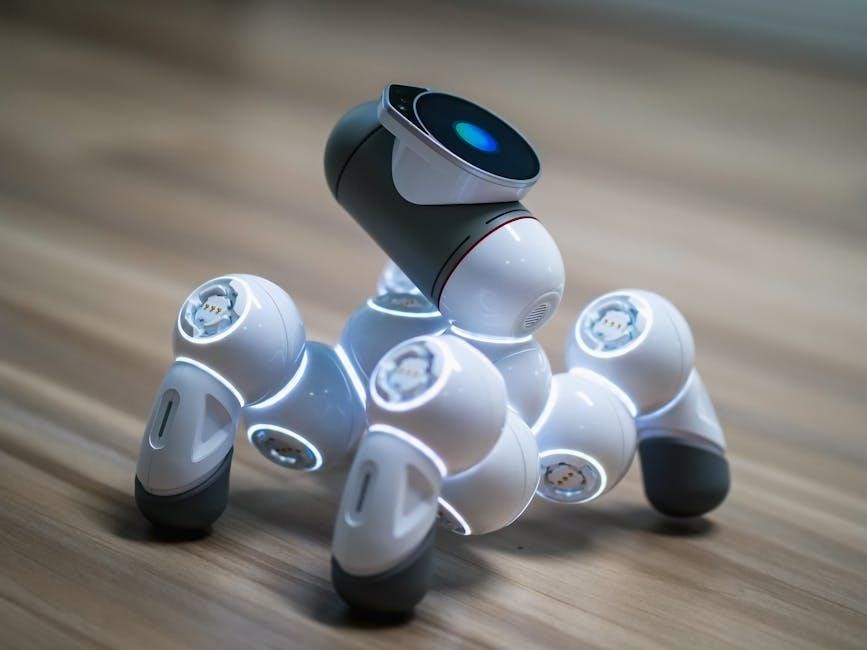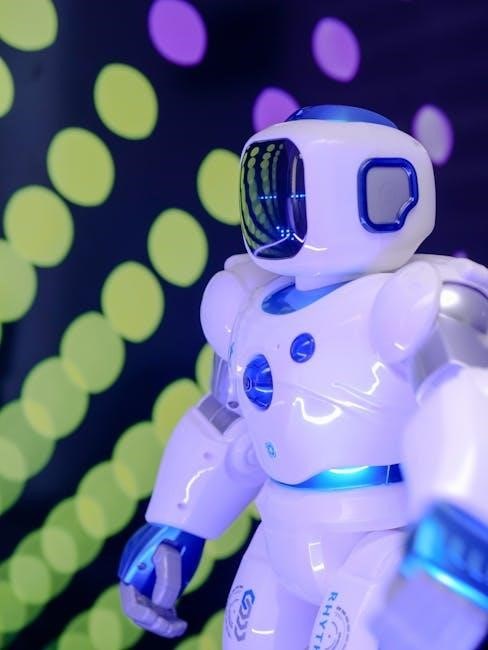LEGO Spike Prime is an innovative robotics and coding kit designed for education, enabling students to create and program creative robots․ With its intuitive interface and modular components, it encourages problem-solving and engineering skills․ Educators can integrate Spike Prime into curriculum seamlessly, fostering hands-on learning experiences․ The kit’s flexibility allows for endless design possibilities, making it ideal for both classrooms and competitions․ Whether you’re a student or a teacher, Spike Prime offers a fun and effective way to explore STEM concepts․
What is LEGO Spike Prime?
LEGO Spike Prime is an award-winning robotics and coding kit designed for students and educators․ It combines creative building with cutting-edge technology, enabling users to design and program innovative robots․ The kit includes programmable sensors, motors, and drag-and-drop software, making it accessible for learners of all ages․ Spike Prime fosters creativity, critical thinking, and problem-solving skills while teaching core STEM concepts․ Whether working individually or in teams, users can bring their ideas to life with this versatile tool․ Educators appreciate its integration into various curricula, while students love its hands-on approach to learning․ With Spike Prime, the possibilities for design and innovation are endless, making it a favorite in classrooms worldwide․
Importance of Coding and Robotics in Education
Coding and robotics are vital in modern education, fostering skills like problem-solving, logical thinking, and creativity․ These disciplines empower students to design innovative Solutions, bridging theory with practice․ LEGO Spike Prime enhances this learning Process, offering hands-on experience with sensors and motors․ Through interactive Projects, students gain confidence in applying Coding and Engineering principles․ Robotics education also_democratizes technology, making it Accessible for all․ It equips students with 21st-century Skills, preparing them for future careers in STEM fields․ With tools like Spike Prime, schools encourage curiosity and innovation, ensuring students are ready to tackle global Challenges․
Why LEGO Spike Prime is Perfect for Innovative Designs
LEGO Spike Prime stands out for its versatility and ease of use, making it ideal for creating innovative robotic designs․ Its modular components and intuitive software allow users to experiment freely, fostering creativity․ The platform encourages experimentation, enabling the construction of unique robots tailored to specific tasks or ideas․ With resources like “LEGO SPIKE Prime ― HOT ROD ― Free Ebook,” aspiring designers can explore advanced concepts while learning through hands-on projects․ Spike Prime also supports seamless integration of sensors and motors, enhancing functionality․ Whether you’re a student or an educator, Spike Prime provides a gateway to unlimited design possibilities, empowering users to bring imaginative ideas to life․ Its user-friendly approach ensures that even newcomers can master the basics quickly․ With Spike Prime, innovation is not just a goal—it’s an achievable reality․

Design Planning
Design planning for innovative robots involves creating detailed blueprints and selecting components to meet specific objectives․ LEGO Spike Prime offers tools for seamless blueprint creation, ensuring efficient and effective prototyping․ This process involves iterative testing and refining to achieve optimal functionality, making it easier to bring creative ideas to life․ By leveraging Spike Prime’s flexibility, designers can explore endless possibilities․

Step-by-Step Design Process
Designing innovative robots with LEGO Spike Prime begins with identifying the project’s objectives and desired functionalities․ Using Spike Prime’s intuitive interface, you can start by creating a basic blueprint, selecting components, and outlining the robot’s structure․ Conduct research to gather inspiration and ensure your design aligns with your goals․ Once the blueprint is ready, assemble the robot, test its functionality, and iterate based on performance․ Finally, refine the design by integrating feedback and optimizing for durability and efficiency․ This structured approach guarantees a successful and innovative outcome․
Research and Inspiration for Robot Design
Designing innovative robots with LEGO Spike Prime requires thorough research and creative inspiration․ Begin by identifying your robot’s purpose and exploring real-world applications to guide your design․ Draw inspiration from existing models, academic papers, or online resources like free eBooks and tutorials․ LEGO Spike Prime’s versatility allows for endless customization, so brainstorm unique features or functions․ Study successful projects to understand problem-solving strategies and engineering practices․ Finally, ensure your design aligns with SPIKE Prime’s components and capabilities to achieve a functional and innovative outcome․ By combining research and creativity, you can unlock the full potential of LEGO robotics․
Brainstorming Ideas for Unique Robots
Brainstorming ideas for unique robots with LEGO Spike Prime sparks creativity and innovation; Start by exploring diverse functions and applications suitable for the kit․ Consider designing robots for specific tasks, such as prosthetics, or for fun, like a competitive bot․ Leverage free eBooks and online resources for inspiration and guidance․ Encourage collaboration and exchange of ideas to refine concepts․ Keep designs flexible to incorporate new features and ensure compatibility with Spike Prime components․ Prototype early and iterate based on feedback to refine your robot’s purpose and performance․ The possibilities are endless, limited only by your imagination and engineering skills․ Embrace the design challenge and bring your unique creation to life!

The Design Process
Design innovative robots using LEGO Spike Prime with a structured approach․ Start by defining the robot’s purpose and problem to solve․ Identify necessary components, sensors, and motors․ Sketch blueprints and prototypes to refine functionality․ Test iterations for performance and durability․ Reference free design guides to enhance your project․ Finalize with robust, competition-ready designs․ Embrace trial and error, learning from each adjustment․
Concept Development and Prototyping
Concept development for LEGO Spike Prime robots begins with brainstorming innovative ideas and defining objectives․ Create detailed blueprints to visualize the robot’s structure, ensuring functionality and scalability․ Use Spike Prime’s modular components to build prototypes, testing attachment points for sensors and motors․ Refine designs based on test runs, focusing on durability and precision․ Document iterations and improvements throughout the process․ Free PDF guides offer valuable insights, providing step-by-step instructions for refining prototypes․ This phase emphasizes trial-and-error, allowing you to refine concepts into functional, competition-ready designs․ Iterate until the prototype meets performance expectations, ensuring seamless integration of hardware and software․ Concept development is the foundation for creating robust, innovative robots with Spike Prime․
Blueprint Creation and Component Selection
Creating a blueprint for your LEGO Spike Prime robot begins with a clear idea of its purpose and functionality․ Map out the structure, ensuring all components are compatible and fit seamlessly․ Consider the size, stability, and scalability of the design․ Organizing the building process becomes smoother with a detailed blueprint, as it guides the selection of the right LEGO pieces, sensors, and motors․ Availability and ease of access to parts are crucial, especially in educational settings where resources might be limited․ Adapting during the process based on testing and feedback is essential․ The Spike Prime PDF free download provides valuable step-by-step instructions, enhancing the efficiency and accuracy of both blueprint creation and component selection․ This ensure the robot meets expectations and functions smoothly․ Careful planning and component choice are vital for a robust design․ Without a solid blueprint and the right components, the design might fail or be unstable․ Iterative adjustments and adaptability are key to achieving the desired functionality and performance of your innovative robot․
Prototype Testing and Iteration

Prototype testing is a critical phase in the development of your LEGO Spike Prime robot, where you can evaluate its performance, functionality, and stability․ Begin by constructing a functional prototype, utilizing the guidance provided in instructional resources such as the “Spike Prime Design pdf free download” or similar materials․ Test the prototype under various conditions to identify potential issues or areas for improvement․ Be open to making adjustments, whether it’s enhancing the robot’s structural integrity or fine-tuning its sensory responses․ Iterate by refining components, ensuring compatibility and flexibility, and adapting designs based on feedback and testing outcomes․ Consider the practicality of modifications for competitions, ensuring that your design is robust yet adaptable․ Iterate until the robot consistently meets its intended objectives and stands out in functionality․ Remember, constant improvements lead to a polished, competition-ready prototype, ensuring your creation is both reliable and innovative․

Building the Robot
Assemble LEGO Spike Prime components, integrate sensors, test functionality, and adjust for optimal performance and innovation․ Download free PDF guides for additional support․
Assembling the Robot Components
Design innovative robots with LEGO Spike Prime by carefully assembling the kit’s components․ Start with the Spike Prime hub, then add motors, sensors, and LEGO bricks to bring your design to life․ Use free PDF guides to ensure accuracy in assembly and explore custom configurations․ Experiment with innovative attachments and structures to create unique functionality․ Test each component for compatibility and stability, making adjustments as needed․ This hands-on process fosters creativity and technical skills, enabling students and educators to build lasting innovations․ Whether for competition or classroom learning, the assembly phase is where ideas transform into functional robots․
Testing and Making Adjustments
After assembling your LEGO Spike Prime robot, it’s crucial to thoroughly test and refine its performance․ Begin by testing individual components, such as sensors and motors, to ensure they function as intended․ If issues arise, identify the problem through troubleshooting and make necessary adjustments․ This iterative process allows for optimization and innovation in your design․ Use free resources like the Spike Prime PDF guide to guide adjustments and improve functionality․ By testing and modifying, you can enhance the robot’s durability, performance, and adaptability to various tasks․ Continuous testing ensures your design meets the intended objectives while incorporating feedback for improvement․
Adding Sensors and Software Integration
Adding sensors to your LEGO Spike Prime robot enhances its functionality and adaptability․ Use the built-in sensors, such as distance, color, or force sensors, to gather data and create interactive behaviors․ For example, you can program your robot to detect objects or follow a line using the color sensor․ Integrating software is essential for bringing your design to life․ LEGO Spike Prime’s intuitive programming app allows you to drag-and-drop commands to control and customize your robot’s movements and actions․ By refining the software code through testing and adjustments, you can ensure seamless sensor integration and optimal performance․ Utilize the free Spike Prime PDF guide to explore advanced programming techniques and customize your robot for specific tasks, making it more intelligent and responsive․

Programming the Robot
Programming LEGO SPIKE Prime involves using intuitive software to bring your robot to life․ With drag-and-drop coding, you can create custom behaviors and control mechanisms, enabling innovative functionalities․ This process allows for endless creativity, as you can tailor your robot’s actions to suit various tasks and challenges․ By leveraging the provided resources, you can refine your skills and push the boundaries of robotic innovation․
Basics of Programming LEGO Spike Prime
Programming LEGO SPIKEPrime begins with understanding its intuitive software platform, which uses block-based coding for simplicity․ Essential commands include controlling sensors, motors, and navigating basic functions․ Students learn to use variables, loops, and conditional statements to create dynamic programs․ Customization enables robots to perform specific tasks, while STEM integration enhances learning․ By mastering these fundamentals, learners lay the groundwork for advanced projects and innovative designs․ Whether troubleshooting or coding new features, the basics ensure smooth project execution and creativity․ This foundation encourages curiosity and problem-solving, preparing users for future STEM challenges․
Debugging and Fine-Tuning the Code
Debugging is an essential step in programming LEGO SPIKE Prime projects․ When your robot doesn’t behave as expected, systematically identify errors by testing individual components and reviewing code logic․ Use the SPIKE app to monitor sensor feedback and motor movements, ensuring accurate responses․ Fine-tuning involves adjusting parameters like speed, timing, and trigger points to optimize performance․ Patience is key, as iterative testing and refinement improve efficiency and reliability․ This process ensures your robot functions seamlessly, meeting design objectives with precision and innovation․
Advanced Programming Techniques and Commands
Advanced programming with LEGO SPIKE Prime involves mastering complex commands and techniques to create sophisticated robots․ Utilize loops and conditionals to control multiple sensors and motors effectively, enhancing functionality․ Experiment with custom blocks to simplify repetitive tasks and improve code efficiency․ Explore concurrency by managing simultaneous actions, and integrate external software or APIs for expanded capabilities․ Fine-tune your code for performance and maintainability, ensuring smooth operation․ The SPIKE app’s Scratch-like interface offers opportunities to innovate, and resources like free PDF guides provide deeper insights․ Embrace experimentation to unlock SPIKE Prime’s full potential and develop advanced, efficient, and innovative robotic solutions․

Customization and Innovation
LEGO SPIKE Prime allows for personalized modifications, enabling users to add unique features like custom sensors or attachments․ Innovators can tailor designs to specific functions, whether for competitions or creative projects․ Free PDF resources provide guidance on advanced customization, encouraging continuous improvement through iterative testing․
Adding Unique Features to Your Robot
LEGO Spike Prime offers endless opportunities to enhance your robot with creative and functional features․ By integrating sensors, motors, and custom attachments, you can design robots with specific purposes or unique behaviors․ Whether it’s adding a gripper arm, a rotating mechanism, or a color sensor, the possibilities are limitless․ Free PDF guides and online resources provide inspiration and step-by-step instructions for designing innovative features․ This flexibility allows you to make your robot stand out, tailored to meet any challenge or task․ With Spike Prime’s modular design, you can experiment freely, ensuring your creation is both functional and engaging․ Whether for classroom projects or competitions, adding unique features is where innovation truly shines;
Customizing the Design for Specific Functions
LEGO Spike Prime enables users to customize robot designs for specific functions by incorporating unique attachments and programming features․ Free PDF guides offer detailed instructions on modifying designs to meet specific requirements․ By adding specialized sensors, motors, and mechanisms, robots can perform targeted tasks such as object detection, autonomous navigation, or gripper operations․ This adaptability ensures that each robot is tailored to its intended application, making it highly effective for solving real-world problems and performing advanced functions․ The modular design allows for endless possibilities, enabling users to create robots that are not only functional but also innovative․ Whether for educational projects or competitions, customizing the design ensures that the robot meets specific challenges and stands out in functionality․
Incorporating Feedback for Continuous Improvement
Incorporating feedback is essential for refining and enhancing robot designs with LEGO Spike Prime․ By testing prototypes and gathering insights, users can identify areas for improvement and implement changes effectively․ For example, adjusting sensor placements or programming logic can optimize performance and functionality․ Free resources, such as detailed PDF guides, provide step-by-step instructions for fine-tuning designs․ By iteratively testing and refining, users ensure that their robots meet specific objectives and operate efficiently in real-world scenarios․ Continuous improvement fosters innovation and adaptability, making the design process both rewarding and impactful․

Optimization and Final Touches
Optimize your robot’s performance by refining mechanics and software․ Ensure durability and adaptability for real-world use․ Final touches include fine-tuning sensors and enhancing functionality․ Free PDF guides and Blueprint resources help perfect your design for flawless execution․
Tweaking for Maximum Performance
To enhance your robot’s functionality, continue testing its movements and interactions․ Adjust programming parameters to ensure smooth operations․ Optimize sensor usage for accurate data collection and response․ Fine-tune mechanisms to reduce friction and improve efficiency․ Refer to the free PDF guides for advanced techniques and troubleshooting tips․ Ensure all components work seamlessly together for peak performance․ Balancing precision and adaptability is key to creating a reliable and high-performing robot․
Ensuring Robustness and Durability
Ensuring Robustness and_durability

To design a robust and durable LEGO Spike Prime robot, prioritize using high-quality, reinforced components and sturdy LEGO pieces․ Implement techniques from the free PDF to enhance structural integrity and longevity․ Test under various conditions to ensure reliability․ Use durable connectors and frames to withstand wear and tear․ Program for adaptability and resilience, enabling the robot to handle unexpected situations․ Regularly inspect and maintain the robot to prolong its lifespan and performance in competitive or educational settings․
Word count:
Final Testing and Preparation for Use
Final testing is a critical step to ensure your LEGO Spike Prime robot is fully operational and ready for its intended application․ Begin by conducting individual component tests, such as verifying sensor responses and motor accuracy․ Integrate these components into the main system and run comprehensive tests to identify and fix any bugs in the code․ Refer to the free PDF guide for detailed testing procedures and checklists to streamline the process․
Prioritize safety by inspecting for loose parts and adding protective guards if necessary․ Organize the final assembly, ensuring all connections are secure and functioning properly․ Perform real-world testing in the environment where the robot will be used to assess its adaptability and reliability․
Prepare a user manual or instructional guide for others to operate or understand the robot’s functionality․ Review test results, make necessary adjustments, and refine the design to meet all project requirements․ Iterate testing and feedback incorporation to enhance performance․ Ensure the robot is ready for deployment, having undergone thorough validation and preparation for its intended use․ This meticulous approach guarantees a robust, safe, and effective LEGO Spike Prime robot ready for action․
